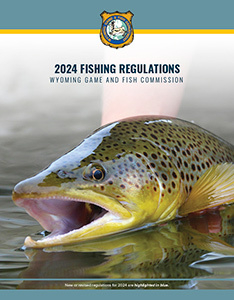Game Fish Species Identification
Illustrations by Michelle LaGory. Splake and tiger trout illustrations by Joseph Tomelleri.
Cutthroat Trout

Black spotting is generally concentrated towards tail (except on the Snake River cutthroat which has a uniform distribution of fine black spots); few or no spots on head, red or orange slash under jaw; no white tips on fins.
Rainbow Trout

Distinguished from cutthroat by the presence of white tips on fins. Distinguished from kokanee by 11 anal fin rays versus 13 to 15 for kokanee. Hybrids (cuttbow) may or may not have a red or orange slash on the lower jaw, but always have white tips on fins.
Brown Trout

Distinguished from cutthroat and rainbow by the general lack of spots on the tail and the light colored “halos” around the dark spots. May have some red or orange spots. Distinguished from brook trout by dark spots on a light background versus light spots on a dark background for brook trout.
Kokanee Salmon

Brilliant red during fall spawning, silvery the remainder of the year. Kokanee have 13 to 15 rays in the anal fin while rainbow trout have 9 to 11.
Brook Trout

Light spots on a dark background. Some red or pink spots with blue halos concentrated on lower half of body. Lower fins and tail have striking white border offset by black. Brook trout have a square tail.
Splake

The splake is a cross between a male brook trout and female lake trout. It can exhibit characteristics of either. The key characteristic to distinguish from a brook trout or tiger trout is a forked tail.
Lake Trout

Light-colored spots on a dark background. Distinguished from brook trout by a deeply forked tail and absence of red or pink spots.
Tiger Trout

The tiger trout is a sterile hybrid of a brown trout and a brook trout. It has a unique, light colored maze-like pattern on a dark background that resembles the stripes of a tiger. The tail is not deeply forked.
Mountain Whitefish

Distinguished from trout by larger scales; from grayling by the small, pointed mouth and smaller dorsal fin, and from suckers and chubs by the presence of the adipose fin.
Grayling

Distinguished from trout by the coarse scales and large dorsal fin. Distinguished from whitefish by the larger dorsal fin, large mouth, and spots on the sides.
Burbot

Slender and elongated body. Large, double dorsal fin that is scarcely separated from the anal and caudal fins producing an almost continuous median fin around the back half of the body. Has a single barbel in center of lower jaw.
Channel Catfish

No scales on body and large barbels near mouth. Often has black spots on sides. Distinguished from black bullhead by deeply forked tail.
Black Bullhead

No scales on dark colored body and large barbels near mouth. Distinguished from channel catfish by lack of deeply forked tail; from stonecat by the lack of a fleshy ridge connecting the adipose and tail fins.
Sauger

Large, silvery eye, large sharp teeth and anterior dorsal fin with spines. Distinguished from walleye by black spots on dorsal fin and wider head.
Walleye

Large, silvery eye, large sharp teeth and anterior dorsal fin with spines. Distinguished from sauger by white marking on lower lobes of tail and anal fins, and a lack of black spots on the dorsal fin nearest the head.
Yellow Perch

Spiny and soft dorsal fins not connected. Back and sides crossed by several vertical bars that are regular in size and shape. Distinguished from walleye and sauger by lack of large prominent teeth and anal fin with 6-8 soft rays rather than 11-14.
Northern Pike

Coloration having horizontal light markings on a dark background. Distinct snout shape similar to that of duck’s bill.
Tiger Muskie

Coloration having irregular narrow vertical dark markings on a light
background.
Largemouth Bass

Body relatively slender. 3 anal fin spines. Dorsal spines usually 10. Distinguished from smallmouth bass by having larger mouth with upper jaw extending far behind middle of the eye and by having spiny and soft dorsal fins that are nearly separate.
Smallmouth Bass

Body relatively slender. 3 anal fin spines. Dorsal spines usually 10. Distinguished from largemouth bass by having smaller mouth, not extending much behind back of eye and by having spiny and soft dorsal fins that are well connected.
Bluegill

Deep body with spiny and soft dorsal fins well connected. 2-3 anal fin spines. 10 dorsal spines. Soft dorsal fin with a black blotch near base of last few rays. Dark “ear” flap on gill plate. Distinguished from green sunfish by smaller mouth not extending to middle of eye.
Green Sunfish

Spiny and soft dorsal fins well connected. 2-3 anal fin spines. 10 dorsal spines. Dark ear flap on gill plate. Distinguished from bluegill by larger mouth with jaw extending to middle of eye.
Fish Hatchery Information
The Wyoming Game and Fish Department currently maintains ten fish hatcheries and rearing stations. These facilities are an integral part of our efforts to provide quality fishing and conserve native species. The hatcheries are located throughout the state. They manage complex operations that include water quality enhancement, genetic selection, detailed production plans and disease prevention in order to raise quality trout, salmon, grayling and tiger muskie for stocking throughout the state. The Department does not have hatcheries to rear coolwater or warmwater fish such as walleye, bass, catfish and bluegill. These species are obtained for stocking in Wyoming by trading trout or trout eggs with other state and federal wildlife agencies. Walleye and bass typically come from North Dakota while bluegill might come from Oklahoma and catfish from Arkansas. Find out more at https://wgfd.wyo.gov/Fishing-and-Boating/Fish-Hatchery-Information.

